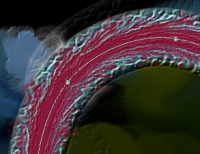Why are we selling Project Dogwaffle 5
for just 5 dollars?
 In
a couple of words: to increase our user
base. We believe that once people use the
software, they will love it, which could
mean future upgrades for us.
In
a couple of words: to increase our user
base. We believe that once people use the
software, they will love it, which could
mean future upgrades for us.
Why version 5?
Version 5 was
released in 2010, after a 3 year hiatus
for us since version 4. It was a huge
undertaking, with lots of new features and
a more modern interface (if you've used
the 2004 free version). Version 5 was the
first version designed to run under
Windows 7/Vista and future operating
systems. To get the most from it however
we ask that you set the “Disable desktop
composition” compatibility flag for the
application. This is because we had not
yet optimized our underlying GUI code for
the new glass look of Windows 7. This is a
simple, one-time step.

Since then, we've released version 6 under
a new name, Howler, followed by 7 last
year, and 8 recently this summer. We feel
that version 5 offers a tremendous amount
of power, while still leaving an
exceptional upgrade option for users who
want more.
What's in
version 5?

Simple answer:
Quite a lot.
On the
painting side, there's tablet support,
multiple undos, natural media painting
with a visual browser to find your media,
advanced color picking such as a palette
mixer, and the red/yellow/blue model from
traditional art. There's of course layers,
drawing primitives like spheres,
rectangles and curves, gradients, alpha
selections, and all the usual stuff.
On the
animation side there's onion skin, lip
syncing with an exposure sheet, a timeline
to apply animated filters to sequence of
frames, or even to animated brushes, and a
number of other features designed for
animators and video types. The developer
was himself a professional animator
(Mystic Knights, Roughnecks: Starship
Troopers Chronicles, Star Trek Voyager,
Max Steel, Dan Dare) In the latest update
to this version, 5.1b, there's even an
animation sequencer called frame painter
that can be used to sequence a small
number of frames into a longer animation.
Technology
wise, version 5 supports multi-threading
and MMX for some pretty impressive speed.
There's some use of the .Net framework
version 4 for certain things. We wanted to
support a modern set of freely available
languages for plugin development, such as
the “Express” versions of the languages
from Microsoft.
What's in
the latest version if I decide to
upgrade?
In version 6,
we gave the program a new name, “Howler,”
and for good reason. There are some bold
improvements in speed, making use of SSE2
as a base level of technology, along with
wider use of threading, and other
improvements.
Later versions
added a number of features. These are just
a few:
- Improvements and additions to painting
tools and tablet support.
- Camera stabilization, including motion
removal, smoothing, or re-addition.
- Rotoscoping
to create garbage or traveling mattes,
and also as an animation tool, as part
of enhancements to the curve tool.
- Multiple monitor support.
- Motion
prediction module to create slow
motion from regular video
- A re-invented timeline editor with
improvements to interactivity and speed.
- New 3-D tools and API.
- Additional improvements to the
interface
- Much tighter integration of plugins
and reduced use of the .Net Framework.
- Second generation particle foliage
tool.
- and a lot more.... see PD
Howler 6, 7 and 8


















